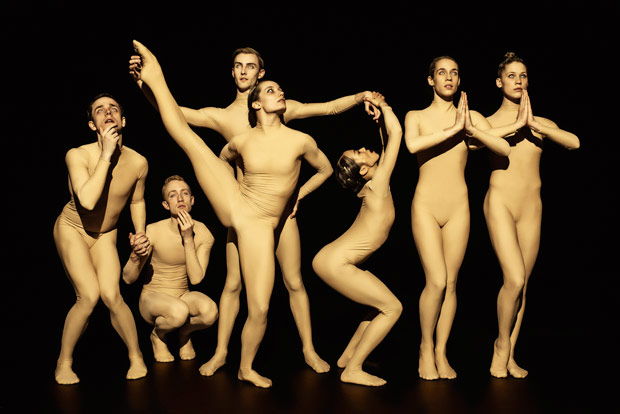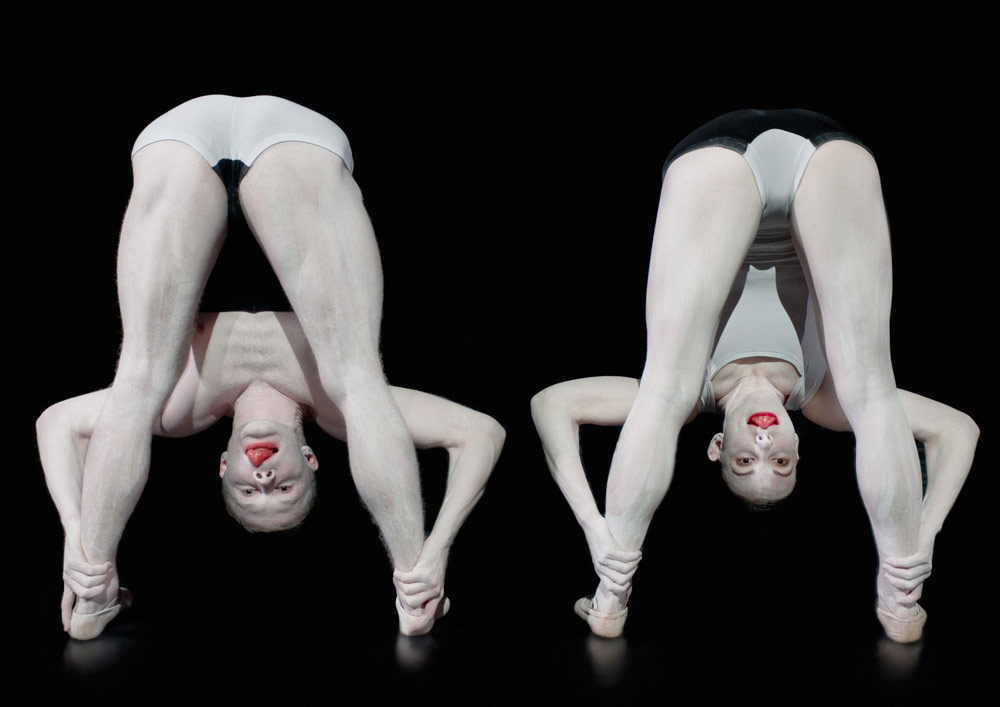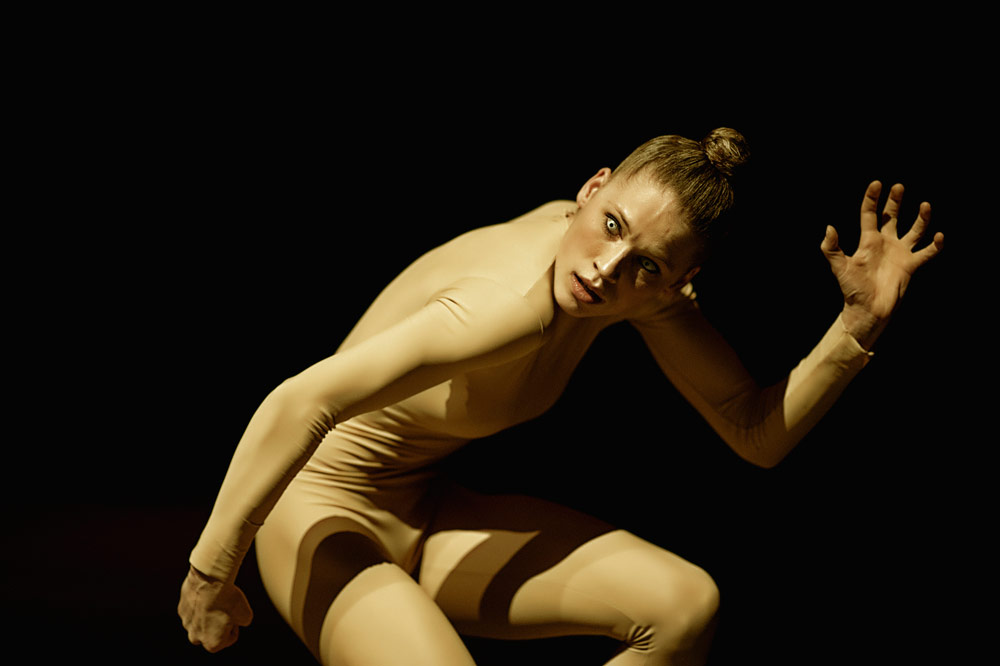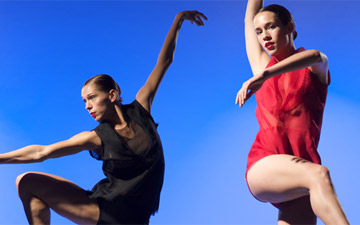
© Rahi Rezvani. (Click image for larger version)
Nederlands Dans Theater 2
I New Then, Shutters Shut, Sara, Subject to Change
New York, Joyce Theater
3 February 2015
www.ndt.nl
www.joyce.org
It isn’t often that a “junior” company gets to perform much outside its home venue, is booked in prestigious venues and sells tickets like gangbusters. But most troupes aren’t Nederlands Dans Theater 2.
There are some companies that are always worth seeing just to watch them move: NDT is one of them, and NDT 2 – at the Joyce through Sunday – is no different. The first, most noticeable, aspect of NDT 2 is the exquisite sensitivity of the dancers, their acute musicality and palpable awareness. There is no give-away to their “apprentice” status – they are fearless professionals. Without the numeric label, most audiences would be hard-pressed to notice the difference. Performing with higher standards than many professional groups, NDT 2’s delivery and execution is right up there with the best. Like its parent company, NDT 2 boasts a repertoire packed with edgy, genre-busting, and difficult choreography that pushes dancers to the physical and dramatic limits.

© Daisy Komen Photography. (Click image for larger version)
But that’s not to say that they don’t have fun. Opening the mixed bill – which is going coast to coast – is Johan Inger’s I New Then. Set to a medley of five songs by Van Morrison, I New Then is fairly breezy, with whiffs of seriousness and sensuality before a full-blown indulgence in sentimentality.
To see the pluck of a guitar resonate in someone’s neck is an amazing thing. It is something dance alone can do, a split-second synthesis between aural and visual senses. Inger’s choreography is largely very good, and musical. The first section, “Madame George”, is perhaps the most successful. “The Way Young Lovers Do,” although meticulously choreographed, is wild, free and cardiovascular. The interpretation of love is fairly literal in “I’ll Be Your Lover Too” but it’s ok, because much of it is beautiful, capturing the impetuousness of early romance. But when it culminates in the couple taking off their clothes upstage left, with the music suddenly seeming to be sourced from a distant boombox, it feels trite. While they strip and poke and sniff and nuzzle each other in the corner, Spencer Dickhaus performs a solo that begins in good humor and morphs into perverse voyeurism. Although Dickhaus is as poised as a ventriloquist at imitating a couple’s intimacy, it doesn’t seem necessary. Then again, this is Nederlands Dans Theatre, and drama is par for the course. In the final movement the entire troupe strips down to the bare minimum, but the sudden costume change to underwear feels superficial and is distracting: somehow the flesh, with all its curves, hollows and shadows, makes the choreography nearly invisible.

© Rahi Rezvani. (Click image for larger version)
It’s probable that Gertrude Stein, who died almost 70 years ago, would have loved Shutters Shut, a droll work set to Stein’s recitation of her poem, “If I told him: A completed portrait of Picasso.” It’s the kind of thing that would fall into the definition of performance art, except that the only people who could do it well are trained dancers. Dickhaus and Imre van Opstal stand before the audience mime-like, their bodies powdered and pale, and engage in a four-minute exercise in wit and rhythm. Stein’s work gets its substance from repetition (albeit a fragment type), and her reading is highly rhythmic. The choreography, by NDT resident choreographers Sol León and Paul Lightfoot, is led by Stein’s hypnotic cadences. Not only cracking good fun, Shutters Shut takes Stein’s work to the third dimension, where Picasso resided, a place you would never arrive – not by reading or listening – on your own.
Although Sara – a collaborative work by Sharon Eyal and Gai Behar – might be the piece most favored by the marketing departments, it had not enough drama or dance to make it stageworthy. Wearing white contact lenses and full footed unitards the color of pancake batter, the dancers look like mutated minions from the land of science fiction, akin to the Precogs from “Minority Report.” The embryonic figures suggest naïveté, while of course providing prophetic warnings (in this case, the lyrics from The Knife’s “From Off to On”). Costumes aside, the action consists of little more than the bulk of the troupe twitching and convulsing upstage right – with a swathe of pop and lock motions taken from the hip-hop canon – while van Opstal crouched, writhed, and gnarled her body and lip-synched.

© Rahi Rezvani. (Click image for larger version)
Dating from 2003, Leon and Lightfoot’s Subject to Change is a crowd-pleasing work. The music? Franz Schubert’s “Death and the Maiden,” as arranged by Gustav Mahler. Heavyweights indeed.
Utilizing the second, or the andante movement, Subject opens with a haunting, funereal march, much like Beethoven’s Seventh (also the second movement). The single prop is a square red carpet, adding an additional plane to the stage. Yukino Takaura and Olivier Coeffard are the primary characters, caught in a web of infatuation and seduction. Although the program notes describe the female character as “fragile,” Takaura, while not hard-hearted or tough, was thankfully not anemic or clingy. Many of the lifts and partnering feats are difficult, but you have to look closely to notice, as Takaura and Coeffard are swift. Lovely lines are created, often without much relationship to the music. Regularly lifted and rolled, the carpet is at its best when swiveled, with Takaura striking a stock-still pose dead center, her body turning like the doll in a ballerina music box. The cinematic nature is amplified to the hilt by Schubert’s sumptuous romanticism (and Mahler’s baroquification of the quartet), making the audience go “wow,” but Subject is carried more by the music than the choreography being musical.

















You must be logged in to post a comment.